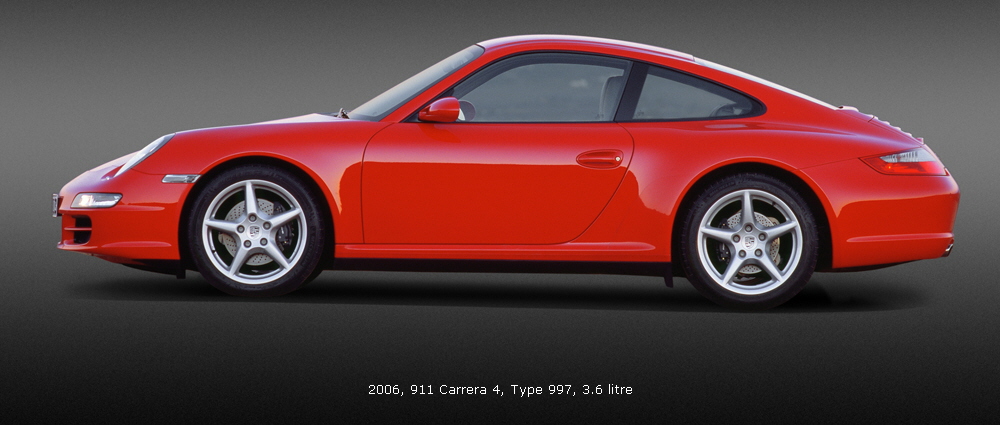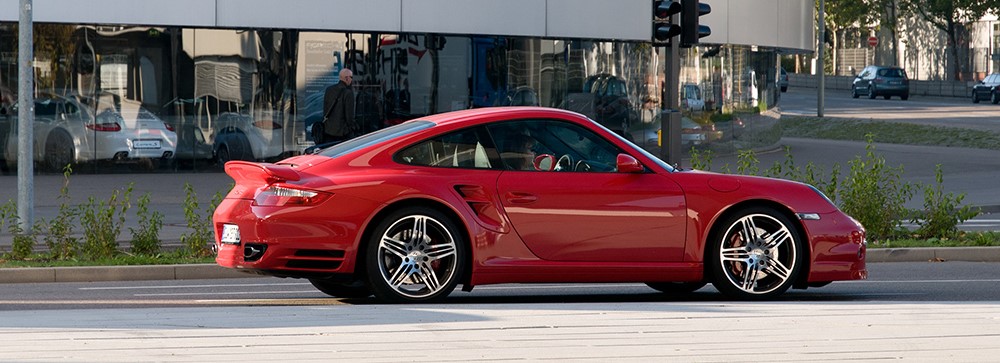
Porsche 911 Carrera (type 997)
From 2005, the Porsche 911 presented itself as being more diverse than ever before: it was available as a Coupé and Targa, Cabriolet and Speedster, with rear- and all-wheel drive, a slimmer and wider body, with water-cooled naturally aspirated and turbo engines, as a GTS version as well as a GT2, GT2 RS, GT3 and two GT3 RS sports versions. Including special models, the range counts 30 model variants – supplemented by numerous customisation options.
With the design of the 997, Porsche honed the 911’s character and gave it an even more dynamic and powerful appearance. The Carrera already looked noticeably more masculine with its more strongly modelled rear, and the S, GT and Turbo models are another 44 millimetres wider. The 997 differentiated itself from its predecessor by the steeper, round, clear-glass headlights, which are an important stylistic element of the air-cooled 911.
Porsche 911 with all-wheel drive (type 997)
Like the 964, 993 and 996, the 997-series 911 is also available with all-wheel drive in the form of the Carrera 4 and Carrera 4S. A new addition is the Carrera 4 GTS, which delivers more power. In this series, the 911 Targa is only available with all-wheel drive as the Targa 4 and 4S – a novelty in the 911 series.
Due to the wider track of the all-wheel drive, the body is a slight 44 mm broader than the all-wheel drive models. Since the 2008 model improvements, the Carrera 4 models are also instantly recognisable by their continuous Red reflector strip between the tail lights.

Porsche 911 : Type 997 (2005-2011)
Classic and modern – By July 2004 the time had come: with the 911 Carrera and 911 Carrera S models, Porsche launched a further 911 generation, which internally was called the 997 range. Its oval, clear glass front headlights with additional lights in the front-end section again reflect the traditional 911 design. However, the 997 impressed not only in its design – its performance was impressive too: the Carrera’s flat 3.6-litre engine produced 325 hp, while the newly developed 3.8-litre engine of the Carrera S delivered no less than 355 hp. Also extensively reworked was the running gear, which on the Carrera S was supplied as standard with Porsche Active Suspension Management. In 2006, Porsche brought out a 911 Turbo, which was the first production car with a petrol engine to have a turbocharger with variable turbine geometry. After the model upgrade in autumn 2008, the 997 became more efficient still thanks to direct petrol injection and a direct shift gearbox. Never before on a 911 had the individuality of the driver been taken into account to such an extent. Carrera, Targa, convertible, rear end and all-wheel drive, turbo, GTS, special editions and road versions of the GT racing cars – in the end the 911 family comprised 24 different models.
- 997 Series……..(2005–2011)
- Models………….997 Turbo, 997 GT3, 997 GT3 RS, 997 GT2, 997 GT2 RS

Porsche 911 Turbo (type 997)
In June 2006, the 997-generation 911 Turbo came onto the market. Thanks to extra power from two exhaust turbochargers, the new Turbo 911 initially had an output of 353 kW (480 PS). The engine was the first series petrol engine to have turbochargers with variable turbine geometry (VTG) that were developed in cooperation with BorgWarner. The inlet-side guide vanes in the turbocharger could be adjusted dynamically. From 2007, the Turbo Cabriolet was available, featuring a three-layer fabric top that opened or closed within just 20 seconds.
After the facelift for model year 2010, the Turbo, with its newly developed engine, delivered 368 kW (500 PS), and the 911 Turbo S from the same model year even had 390 kW (530 PS) and a Porsche Doppelkupplung (PDK) as standard.


2008: Porsche Doppelkupplung PDK S
The optionally available Porsche Doppelkupplung (PDK) was featured in a series production sports car for the very first time when it was fitted into the 997 series of the 911 in 2008. It had seven forward gears and one reverse gear and was initially available in the Carrera and Carrera S. Its most important advantages were faster gear changes in comparison with manual gearboxes and automatic converter gearboxes. The gears were already engaged when the driver changed gear and drive was not lost during the process.
The PDK also provided weight benefits – despite two additional gears in comparison with the manual gearboxes which were prevalent at that time, it weighs approximately ten kilogrammes less than the Tiptronic S gearbox. In the 1980s, Porsche was the first manufacturer in the world to use this gearbox technology successfully in motor racing in the 956/962 and therefore it had the most experience with dual-clutch gearboxes for high-performance sports cars. The Porsche Doppelkupplung combined the driving dynamics and the good mechanical efficiency of a manual gearbox with the shifting and ride comfort of an automatic gearbox. The PDK was therefore designed in line with the requirements of a 911 driver, in terms of both sportiness and comfort. The first six of the seven forward gears had a sporty setup whereas the seventh gear had a long ratio for maximum fuel economy.
Porsche 911 GT2 (type 997)
When it was launched in 2007, the 911 GT2 (type 997) was the fastest street-legal 911 ever built. Developed by the Motorsport Department in Weissach, it carries all of the sporty genes that a road vehicle suitable for the racetrack needs.
The GT2 has the widened body of the 911 Turbo, but is rear-wheel drive instead of all-wheel drive. A significant reduction in weight also contributes to the impressive driving performance.
Porsche 911 GT3 (type 997)
The model improvements of the 911 GT3 of the 997 generation appeared in 2006. Compared to its predecessors, many pieces of equipment were included as standard, such as the Porsche Active Suspension Management (PASM) sports chassis. The GT3 was also available with a Clubsport Package for use in motorsport.
From MY 2009, the revised high-performance naturally aspirated engine delivered 320 kW (435 PS) instead of the previous 305 kW (415 PS).
Those who wanted even more than the GT3 had to offer could also order the 911 GT3 RS with 305 kW (415 PS) from 2006. This version was even more resolutely equipped for racing. In its final stage of evolution, as the 911 GT3 RS 4.0, it delivered a total of 368 kW (500 PS).
